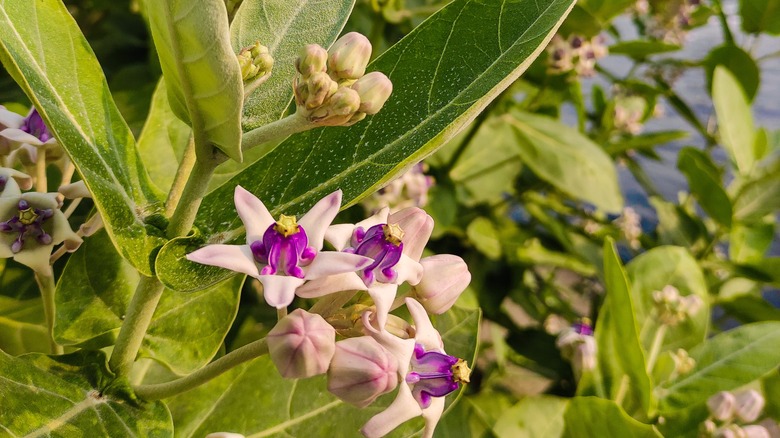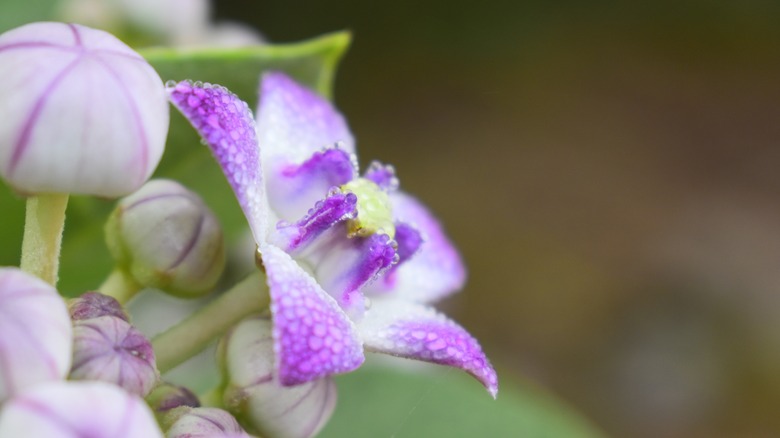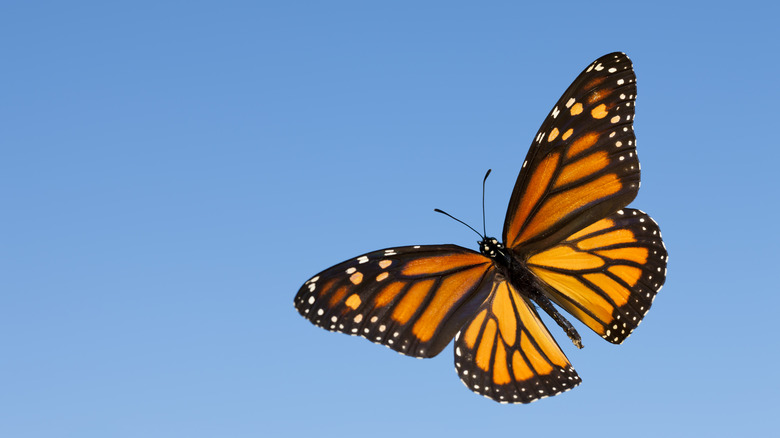Feed Monarchs With This Regal Milkweed
Crown flower (Calotropis gigantea), also known as giant milkweed or swallow-wort, is a fascinating plant native to tropical regions like India, Malaysia, Southern China, and Indonesia. Its distinctive star-like flowers are said to be sacred to the Hindu people, and the blooms were a great favorite of Hawaii's last queen, Liliuokalani. Crown flower is a popular landscaping plant on the islands, and the flowers are used to make fragrant leis. This shrub can grow anywhere from eight to 10 feet in height and is even taller in its native tropical climate. It can be grown from seed as well as propagated by cutting and is incredibly hearty. Like most milkweeds, Calotropis gigantea is incredibly resilient and can even deal with a bit of neglect.
This flowering shrub has gained recognition for its role as a vital food source for monarch butterflies during their lifecycle. The leaves of the crown flower plant are rich in nutrients, and monarch larvae feed voraciously on them. The flowers are frequently visited by other species of flying pollinators, making it a great way to attract them to your garden space.
Growing and cultivating crown flowers
Although it does best in warmer climates, cultivating crown flowers is a pretty straightforward process. For successful growth, it's important to use well-draining soil and ensure the plant has full exposure to the sun. A little shade won't do it any harm, though. As with most plants, soil that's fertile and enriched with organic matter will yield the best outcome.
When it comes to planting giant milkweed, you have two options — seeds or propagation through a stem cutting. If you live in a warmer climate, seeds can be sown directly in the ground. However, if you live in an area where the temperatures dip and frost is a likely possibility, it's recommended that you start your seeds indoors and then transplant them once they have an established root system. Established plants are hearty and tolerate drought, but up until then, regular watering is necessary (especially during dry spells). If you live in a dry environment, try mulching to help with moisture retention. This also helps present undesirable weed growth. Giant milkweed can be propagated by using softwood stem cuttings dipped in rooting hormone powder in soil or started in water. Adding perlite or sand to the potting soil improves drainage.
It's a one-stop shop for monarch butterflies
Crown flower serves as the exclusive food source for monarch butterflies in Hawaii, and plays a crucial role in their life cycle. While crown flower may not necessarily attract butterflies for nectar-sipping, it acts as their host plant and also attracts bees, birds, and other pollinators. Because of its gigantic size (hence the name), the giant milkweed can support monarch butterflies through each life stage. Caterpillars don't even have to venture out and find a suitable location to take their eight to 12-day transformative siesta.
Milkweed plants, in general, are important for conserving monarch butterflies. These endangered creatures rely on milkweed as their sole host, providing them with food and a place to lay eggs. It's not just about planting milkweed in your yard. By planting an assortment of milkweeds, like the crown flower or butterfly weed, along with nectar-rich flowers, you're attracting and nourishing more butterflies and helping to keep the species from extinction.


